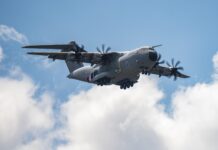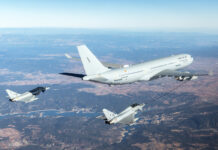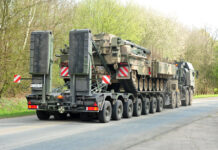In the last 18 months, Airbus reached the significant milestone of 100 operational A400M aircraft delivered. Clearly, the aircraft is well on its way to overcoming several long lasting development hurdles.
The European ”big players” recently had reason to celebrate reaching 100 A400M deliveries with the 10th out of 27 A400M aircraft supplied to the Spanish Air Force. The aircraft MSN111 performed its ferry flight on 24 May from Seville to Zaragoza, where the Spanish A400M fleet is based. In the same week, the A400M global fleet also achieved the 100,000 flight-hours landmark performing missions worldwide for all eight customer nations. This represents a significant boost in activity, with 40,000 hours added since late 2019.
Protracted and Nasty Issues
The A400M programme was formally launched in May 2003, with partner nations Belgium, France, Germany, Luxembourg, Spain, Turkey and the UK committing to a combined total of 170 aircraft, with four for export customer Malaysia. Since its maiden flight on 11 December 2009, the loss of a prototype and several long-lasting issues seem to have been forgotten. Obviously, Airbus overcame the production faults affecting 14 propeller gear boxes (PGBs) produced by Italian supplier Avio Aero and a necessary interim PGB fix to resolve the problem (those PGB-retrofitted units reportedly have had no problems since), or input pinion plug cracking which released small metallic particles into the oil system. Some issues still remain, including the low- and high-pressure turbine discs of the Europrop TP400-D6 engines, once underestimated as made by – as Airbus‘ Tom Enders once said himself – “an inexperienced consortium“, or the subsequent US$1Bn charge over delivery issues and export prospects in 2016. A so-called ”re-baselining-contract” signed with the European launch nations in 2019 reduced the final assembly of the A400M to its current rate of eight to nine per year, thereby safeguarding manufacturing until 2030. In this context, it was agreed to extend the entire delivery by six years. Instead of the previous target of 2020, all 174 on the books are now due to be delivered by 2026. Nevertheless, the engine still seems to resemble a kind of burden for the operators, since Airbus is working with the consortium and the EU-regulators to re-certificate a new standard for the power plant. This is expected to happen this July – also enabling Airbus to establish new, “less conservative” maintenance schedules. Nevertheless, company officials do not deny they are not where they want to be on supportability, fleet availability and maturity. Airbus therefore calls for a “maturity drive”, which will run until 2023.
Unique Props
Part of the “burden” is – or was – design-inherent. Because on the largest European heavy-lifter (with its +30-tonne payload), the pair of propellers on each wing turn in opposite directions, with the tips of the propellers advancing from above towards the midpoint between the two engines. This is in contrast to the overwhelming majority of multi-engine propeller driven aircraft where all propellers turn in the same direction. The counter-rotation is achieved by the use of the gearbox fitted to two of the engines and with this, only the propeller turns in the opposite direction. All four engines remain identical and run in the same direction. The reason behind this – given by the manufacturer – was, that this eliminates the need to have two different engines on stock for one aircraft, simplifying maintenance and supply costs.
Further “Milestones” Reached
Recently, the A400M successfully conducted a major helicopter air-to-air refuelling certification flight test campaign in coordination with the DGA (French Directorate General of Armaments), completing the majority of its certification objectives, including the first simultaneous refuelling of two AH H225M CARACAL CSAR-helicopters. It was mainly the French who pioneered a 36.5 m hose, which eliminated the serious turbulence issue of the previous 24 m hose in combination with spoilers activated to hold the slow refuelling-speed. Also, recent tests were completed in Spain in collaboration with the UK’s Royal Air Force parachute test team, to expand up to 25,000 ft for automatic parachute opening and up to 38,000 ft for free fall. The A400M is already able to drop up to 116 paratroopers, via simultaneous dispatch from the side doors with automatic parachute opening, from the ramp with automatic opening or in freefall, day and night. Also to note is performing automatic low-level flight in instrument meteorological conditions.
In German Service
While the ATLAS – as it is also called – has made great strides so far this decade in both development and operational terms, it has proven its value to nations during their pandemic response efforts. Utilisation rates for this large transport plane have soared everywhere since the start of the COVID-19 crisis, with flight hours in 2020 up 40 per cent on the previous year. On 5 May, the German A400M 54+05 delivered parts of an oxygen-generation device to India, flying from Wunstorf to New Delhi. In the qualified MEDEVAC-role, the type also supported the re-location of COVID-infected Germans from Afghanistan.
Related to the overall introduction and service in(to) the German Luftwaffe (GAF), since the last armament-report to the Parliament (Bundestag) from spring 2020, additional A400M aircraft delivered and accepted have brought the inventory to 35 (or meanwhile 36) out of the planned 53. The latest aircraft is a so-called “tactical version”, meaning it is equipped with a self-defence/countermeasures system based on DIRCM. Therefore it remains with Airbus in Spain, with the official handover connected to the DIRCM-fit, which should become operational on German A400M aircraft by 2024. Only 37 of the fleet will be “tactically” modified this way in the end. With current planning for 2021, two further airframes are scheduled to be delivered.
The next contracted ability-standard is NSOC 2.0, as accepted by the programme nations. It is described as an important milestone towards final standard SOC 3.0 (FOC) scheduled for acceptance in 2023. At this point, it needs to be mentioned that once new clearances are made by the company, national flight trials and approval processes can take a further 12-18 months to complete.
Other Operators…
With two operators, the ATLAS is bound to take over more share of the market, since the Spanish Air Force retired its Lockheed Martin C/KC-130H transports last December and the RAF will cease operations with its remaining 14 J-model HERCULES – having accumulated only between 9,000 and 12,000 hours – much earlier than anticipated. This also means commitment and belief in the level of maturity the A400M has reached and interest in boosting the operational capabilities of its ATLAS fleet, as detailed in late March in the UK MoD’s “Defence in a Competitive Age“ planning document for the period 2021-2025. This means including operations from unpaved runways or potential new applications for a transport, such as in supporting maritime patrol activities. The RAF already uses this aircraft type for such work while defending the Falkland Islands. It has so far received 20 of its contracted 22 ATLAS aircraft, with the remainder to follow in July 2022 and June 2023. London’s original commitment to the programme was for 25 units, but this was cut by three ahead of the programme’s launch order.
France meanwhile is using the aircraft regularly in its military’s peacekeeping activities in West Africa. Nine Turkish Air Force A400Ms based in Kayseri have evacuated Turkish, Azeri, Albanian and Georgian citizens from Wuhan, China. They have also however, delivered armaments to Misrata for the Turkish-backed Tripoli-based Libyan Government of National Accord. The third aircraft (MSN023) crashed during the first factory acceptance flight from Seville in 2015 and will be replaced with the tenth in 2022. Meanwhile in 2020, the Malaysian Air Force has received a Cargo Hold Part Task Trainer (CPTT) simulator from Rheinmetall. It has been reproduced to exactly the same original scale with all operating elements to train staff in the cargo bay. The TUDM operates four A400Ms.
Future Prospects
There is flexibility to increase production to 11 or 12 aircraft per year – or even more – should demand dictate. At Airbus, there is optimism about future additional sales of the ATLAS – both to existing operators and new international customers. Some even predict the A400M will enjoy major export success, while several nations around the globe – likely in Africa, the Asia-Pacific region and the Middle East – are merely observers. Indonesia, which had earlier talked about five aircraft, instead expressed interest in early 2018 in taking just two to support domestic logistics and humanitarian operations. Rather unexpectedly, there are indications that Airbus, with the A400M is – more or less closely – involved in the European 6th Generation Future Combat Air System (FCAS). Within that system-of-systems “combat cloud”, the ATLAS could air-deploy remote carrier vehicles or even wingman-like UCAVs. According to company statements, flight trials have already taken place with one of the nations.
This article originally appeared in the July issue of European Security & Defence. Click hereto download the full issue in PDF format.



![Transport aircraft trends: A market overview The Xi’an Aircraft Industrial Corporation (XAC) Y-20 entered service with the Chinese military in 2016; the aircraft can be considered the Chinese equivalent of the Boeing C-17. A tanker variant is available, while the Y-20 also provides the basis for the new KJ-3000 AEW&C platform. [Cute Orca Weibo Account]](https://euro-sd.com/wp-content/uploads/2025/06/Y-20-China-Kopie-218x150.jpg)

![Europe’s airlift rejuvenation: is it enough? An Airbus A400M in French service, pictured on 25 June 2024. As things stand there will ultimately be 170 A400Ms in service with European air forces. [Armée de l'Air et de l'Espace]](https://euro-sd.com/wp-content/uploads/2025/06/French-A400M-Armee-de-lAir-et-de-lEspace-Kopie-218x150.jpg)





